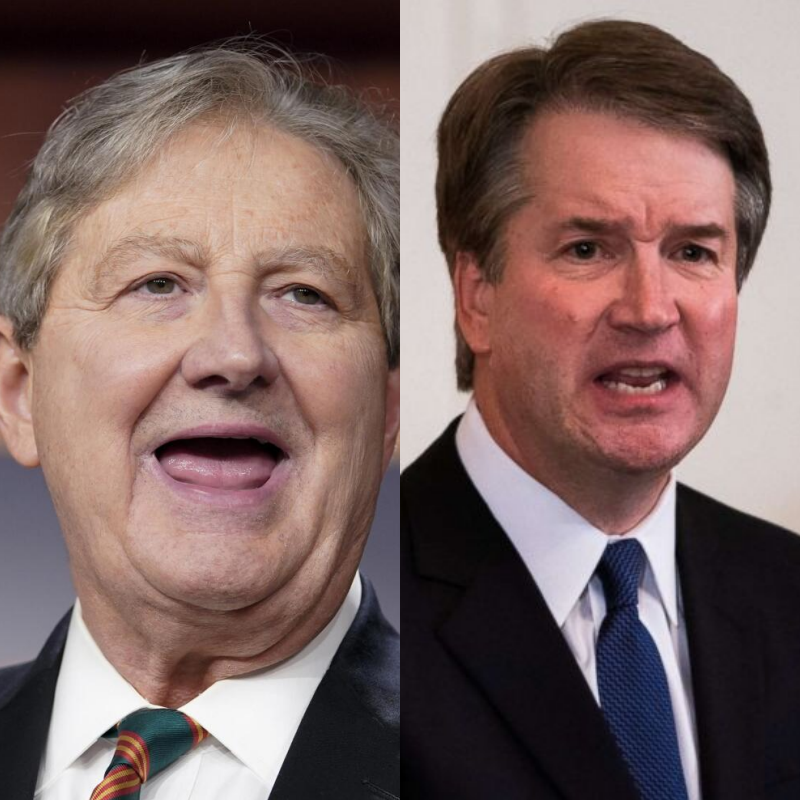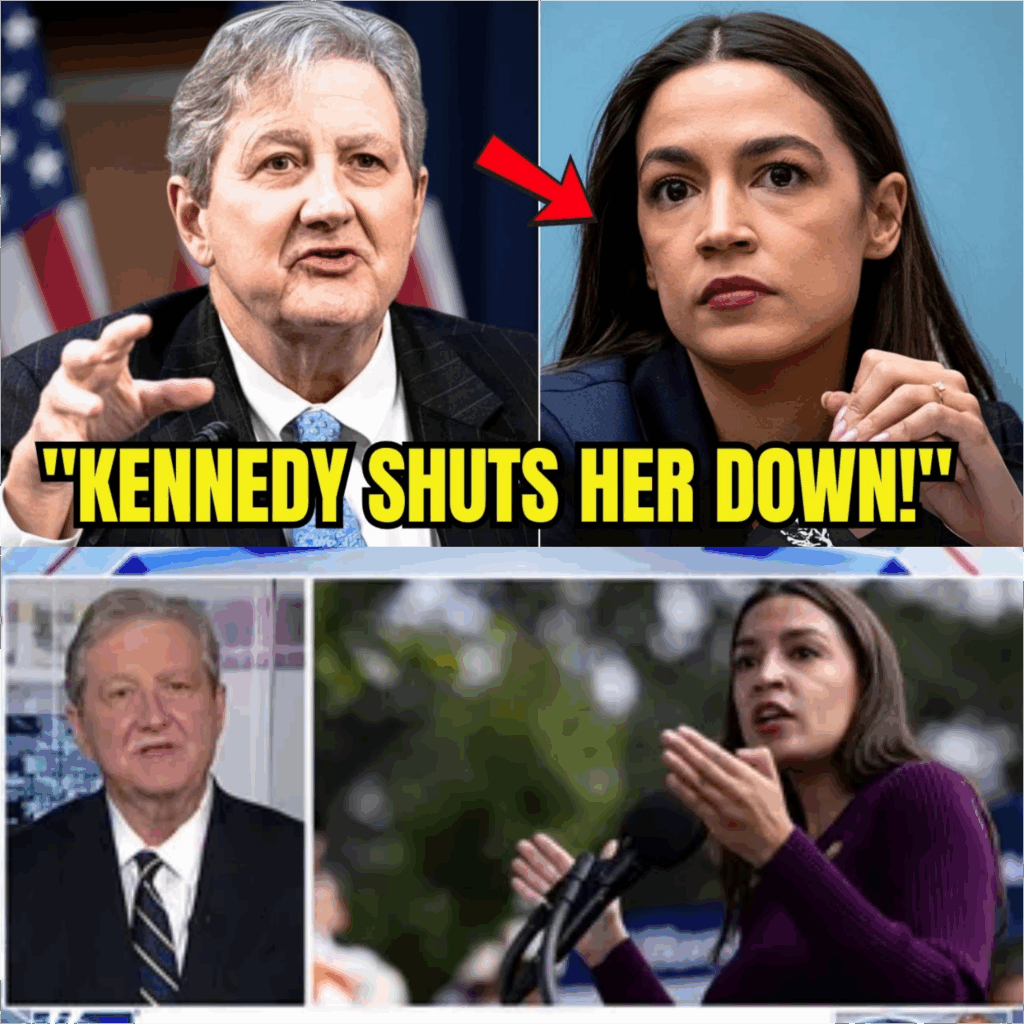Senator Kennedy’s Ethics Card for Kavanaugh: A Humorous Gesture or a Major Snub?
Tension in the Hearing Room: Senator Kennedy’s Ethics Card Confrontation with Justice Kavanaugh
In a dramatic moment that captivated the nation, Senator John Kennedy confronted Supreme Court Justice Brett Kavanaugh during a recent Senate Judiciary Committee hearing, presenting him with an “ethics card” that ignited a firestorm of controversy. The seemingly innocuous gesture quickly spiraled into a high-stakes showdown, highlighting the tension between ethical accountability and judicial independence.
The Setup: A Tense Hearing Room
The scene was set in the Senate Judiciary Committee room, where the atmosphere was thick with anticipation. Cameras flashed as Senator Kennedy approached Justice Kavanaugh, who sat at the witness table, exuding confidence. Kennedy, known for his sharp wit and straightforward demeanor, handed Kavanaugh a small white card emblazoned with ethical guidelines that every federal judge swears to uphold.
“Do you recognize the code you swore to uphold?” Kennedy asked, his voice steady but piercing. The room fell silent, every eye fixed on Kavanaugh as he hesitated, holding the card without speaking. The tension was palpable; even the staff behind Kavanaugh shifted nervously in their seats..
.
.
.

The Ethics Card: A Symbol of Accountability
The ethics card, while modest in size, became a powerful symbol in the hearing. It contained the oath that Kavanaugh had taken upon his appointment to the Supreme Court, a reminder of the ethical standards expected of him. Kennedy’s gesture was not merely a joke; it was a deliberate provocation aimed at holding Kavanaugh accountable for his actions and decisions.
As Kavanaugh’s fingers brushed the edge of the card, he remained silent, prompting Kennedy to press further. “This is the code you swore to. Do you recognize it?” The senator’s insistence turned the moment into a spotlight on the judge’s commitment to ethical conduct.
The Moment of Truth: Kavanaugh’s Hesitation
Kavanaugh, who had previously spoken eloquently about judicial independence and ethical standards, now found himself cornered. His initial confidence began to wane as the pressure mounted. “I’m committed to the highest ethical standards,” he finally stated, attempting to deflect the confrontation. However, Kennedy was relentless.
“Procedures aren’t principles,” Kennedy shot back, emphasizing that the ethics card represented more than just a set of guidelines; it was a promise to the American people. The optics of the situation were brutal. The card lay between them like evidence in a trial, and Kavanaugh’s refusal to engage with it spoke volumes.
The Shift in Power Dynamics
As the hearing progressed, it became clear that the balance of power had shifted. Kennedy’s calm demeanor contrasted sharply with Kavanaugh’s growing discomfort. The senator’s questions cut through the tension, turning Kavanaugh’s hesitations into contradictions. Each pause in Kavanaugh’s responses seemed to amplify the stakes, and the atmosphere grew increasingly charged.
The press bench leaned forward, reporters typing furiously as the drama unfolded. Kennedy’s strategy was clear: he was not only questioning Kavanaugh’s actions but also using the ethics card to expose a potential hypocrisy in the justice’s refusal to acknowledge the very standards he had once championed.
The Leaked Memo: A Game Changer
Just as the tension reached its peak, a committee clerk burst into the hearing room, carrying a thin folder and a phone flashing with notifications. This unexpected interruption added a new layer to the confrontation. Kennedy seized the moment, sliding the leaked memo across the table to Kavanaugh.
“Before you answer, I’ve just received a record,” Kennedy stated, revealing that the memo contained internal instructions regarding how Kavanaugh should navigate ethical inquiries. The room erupted in whispers as reporters processed the implications of the leak.
The memo, dated six months prior, instructed Kavanaugh to “avoid direct engagement with external ethics inquiries” and to “preserve judicial independence optics at all costs.” This revelation was a bombshell, suggesting that Kavanaugh had been aware of the ethical implications of his actions and had crafted a strategy to sidestep them.
The Fallout: Kavanaugh’s Dilemma
Kavanaugh’s composure cracked as he faced the weight of his own words. Kennedy’s calm questioning transformed the memo into a weapon, forcing the justice to confront the contradiction between his public statements and private strategies. “You predicted this confrontation. You scripted your refusal, but you didn’t plan for the leak,” Kennedy asserted, driving home the point that Kavanaugh’s actions were under scrutiny.
Kavanaugh attempted to frame his response, claiming the memo reflected “internal strategy, not misconduct.” But Kennedy was unyielding. “It reflects intent. And now it’s public,” he countered, as the implications of Kavanaugh’s actions became increasingly clear.
The Public’s Reaction: A Turning Point
As the hearing unfolded, the public began to take notice. News tickers updated in real-time, and social media exploded with reactions to the confrontation. Hashtags like #ReadTheCode began trending, reflecting a growing demand for accountability from public officials. Viewers at home could sense the gravity of the moment, and the implications of Kavanaugh’s refusal to engage with the ethics card resonated far beyond the hearing room.
Kennedy’s strategy was working. He had turned Kavanaugh’s own words against him, creating a narrative that would dominate headlines for days to come. The optics of the situation painted Kavanaugh as someone unwilling to uphold the very standards he had publicly espoused.

The Climactic Moment: Kennedy’s Closing Statement
As the hearing drew to a close, Kennedy leaned into the microphone, his voice steady and authoritative. “Judge, ethics aren’t optional. They’re the line between justice and power. And you just showed the country which side you’re on.” The weight of this statement hung in the air, leaving Kavanaugh visibly shaken.
The silence that followed was deafening. Kavanaugh sat frozen, his mouth opening and closing as he struggled to respond. The cameras captured every moment, broadcasting the tension to viewers across the nation.
Kennedy stood, collecting his materials without glancing at the cameras. “This committee will remember your silence,” he stated, his back straight as he walked toward the exit. The optics were powerful, symbolizing a decisive moment in the ongoing conversation about ethics and accountability in government.
Conclusion: A Defining Moment in American Politics
The confrontation between Senator Kennedy and Justice Kavanaugh marked a significant moment in American politics. It highlighted the importance of ethical accountability for public officials and the need for transparency in the judiciary. As the fallout from the hearing continued to unfold, it became clear that Kavanaugh’s refusal to engage with the ethics card would have lasting implications for his reputation and the public’s trust in the Supreme Court.
In the weeks that followed, discussions about judicial ethics and accountability dominated news cycles, with many calling for greater scrutiny of the actions of Supreme Court justices. Kennedy’s bold move to confront Kavanaugh not only captured the attention of the nation but also set a precedent for future hearings, reminding public officials that their words and actions would be closely examined by the public they serve.
As the country grapples with issues of trust and integrity in leadership, the events of that hearing will be remembered as a pivotal moment in the ongoing quest for accountability in American governance.
Moments from Disaster: Tanker Caught Under a Crumbling Bridge

A Disturbing Sight Emerges
What starts as an ordinary-looking clip quickly transforms into something chilling—almost too dramatic to believe.
A fuel tanker is seen motionless beneath a bridge that looks like it’s seconds away from total failure. Each crack, shift, and creak in the concrete seems to hint at an unavoidable collapse. But the real mystery is this:
was this an actual tragedy captured on camera, a close call that never made headlines, or a staged performance meant to provoke fear? The viral TikTok video offers no explanations, only unanswered questions—keeping millions hooked and uneasy.

A Viral Storm of Suspense
The short but intense footage, now circulating across TikTok and other platforms, has shocked audiences around the world. It shows a large tanker halted directly under a visibly unstable bridge, where fractured slabs of concrete droop dangerously overhead. With the vehicle trapped in place, the scene looks like the final countdown to disaster. Nicknamed “Seconds from Collapse” by social media users, the video has ignited fierce debates about infrastructure safety, emergency preparedness, and the terrifying unpredictability of life.
Inside the Clip
The footage begins with a tense shot of the tanker positioned under a damaged bridge frame. Jagged cracks split the concrete above, while the steel support beams seem too weak to withstand the strain. The implication is immediate and terrifying—one more shift, and the bridge could come crashing down.
Online captions, however, tell different stories. Some insist the incident was the result of an aging bridge failing under stress, while others argue it happened during demolition or repair work. The lack of verified information only heightens the suspense, leaving people to speculate: was it real, staged, or something in between?
Why It Strikes a Nerve

The reason viewers can’t look away lies in a deeply human fear: the sudden collapse of structures we rely on every day. Bridge failures aren’t just hypothetical scenarios—they have happened across the globe, leaving scars that linger in memory. This video taps into that anxiety, reminding people of moments when ordinary commutes turned into scenes of chaos and loss.
Real-Life Echoes
Even without clear origins, the video’s imagery reflects chillingly similar events:
Taiwan (2019): The Nanfang’ao Bridge collapsed without warning, sending a tanker and several fishing boats crashing into the sea. Footage of the incident spread worldwide within hours.
India (2025): Gujarat’s Gambhira Bridge gave way during morning traffic, leaving a tanker dangling from the broken span. Rescue teams worked for weeks in a high-risk environment to secure it.
Brazil (2024): A major highway bridge collapsed as a tanker carrying sulfuric acid crossed it. Both the vehicle and sections of roadway plunged into a river, causing both human and environmental devastation.
These real disasters give the viral clip an added weight. Even if staged, the video mirrors tragedies that have already unfolded in real life.
Beyond the Drama
The spread of this video highlights a larger issue: a growing unease about the safety of public infrastructure. Across the world, countless bridges and highways are operating far beyond their intended lifespan. Insufficient repairs, increasing traffic loads, and financial neglect all contribute to the risk. The viral “seconds from collapse” imagery has become a metaphor for that vulnerability—showing how quickly stability can shatter when systems fail.
At the same time, such incidents also reveal the courage of ordinary people. From drivers who act in split seconds to save others, to rescue teams who risk their lives during collapses, these moments show that resilience can shine even in the darkest circumstances.
Final Reflection
Whether the viral TikTok depicts a genuine accident, a staged awareness video, or simply a dramatic moment filmed during controlled work, its influence is undeniable. The sight of a tanker frozen beneath a deteriorating bridge captures a universal fear: being trapped in the instant before disaster strikes.
More than fleeting entertainment, the image has become a stark reminder. It warns that safety is fragile, that vigilance is essential, and that neglecting infrastructure can turn routine days into catastrophic headlines. In a world where one overlooked crack can lead to collapse, the message is clear—preparedness isn’t optional; it’s survival.





